Optical Properties of Crystalline Lactose Fluidized with Dilutions of Various Substances in the Terahertz Frequency Range
Abstract
:1. Introduction
2. Materials and Methods
2.1. Lactose Formulations Preparation
- Lactose not subjected to any treatment is hereinafter referred to as “intact lactose”.
- Lactose (lactose monohydrate) saturated with a solution of affinity-purified rabbit polyclonal Abs to IFN- that had previously undergone a process of gradual reduction of their initial concentration under specific conditions [29]. Briefly, Abs to IFN- (2.5 mg·mL) were mixed with aqueous ethanol solution at a 1:100 ratio with intensive vibration treatment to produce the first centesimal dilution. All subsequent dilutions contained 1 part of the previous dilution and 99 parts of the solvent. The final solution contained a mixture of 12, 30, and 50 centesimal dilutions of Abs to IFN-. The estimated theoretical Abs concentration in the final solution was no more than 2.5 × 10 mg·mL, or 2.5 × 10 ppb (). However, according to the physicochemical studies, for the samples manufactured using the technology of high dilutions, such estimation might not be correct due to nonlinear reduction in solute concentration. Indeed, it was shown that even in dilutions lower than 10, the solute molecules can be preserved due to the flotation effect [30,31,32,33,34]. The original substance of the Abs was produced following the current EU requirements of Good Manufacturing Practice for starting materials [35] by AB Biotechnology (Edinburgh, UK). Hereinafter, lactose saturated with dilutions of Abs to IFN- is referred to as “Abs saturated lactose”.
- Lactose treated using the same technology as above, but glycine buffer was taken as the initial solution for dilutions (instead of Abs to IFN-). This formulation is hereinafter referred to as “GB saturated lactose”.
- Lactose treated using the same technology as the previous two, but deionized water, obtained using a Milli-Q water purification system (Merck Millipore, Darmstadt, Germany) with conductivity of 18.3 M cm, was taken as the initial solution (instead of Abs to IFN- or glycine buffer). Namely, deionized water had undergone a process of gradual reduction of its initial concentration via mixing with aqueous ethanol solution, according to the procedure described above. This formulation is hereinafter referred to as “technological control”.
2.2. Experimental Setup
2.3. Principal Component Analysis for Sample Identification
3. Results and Discussion
3.1. Terahertz Optical Properties of Lactose Monohydrate Tablets
3.2. PCA of the Lactose Monohydrate Tablets
4. Conclusions
Author Contributions
Funding
Institutional Review Board Statement
Informed Consent Statement
Data Availability Statement
Conflicts of Interest
Sample Availability
Abbreviations
| UV | Ultraviolet |
| THz | Terahertz |
| THz-TDS | Terahertz time-domain spectroscopy |
| SNR | Signal-Noise Range |
| PC | Principle component |
| PCA | Principle Component Analysis |
| Abs | Antibodies |
| INF- | Interferon-gamma |
| GB | Glycin buffer |
References
- Facioni, M.S.; Raspini, B.; Pivari, F.; Dogliotti, E.; Cena, H. Nutritional management of lactose intolerance: The importance of diet and food labelling. J. Transl. Med. 2020, 18, 260. [Google Scholar] [CrossRef] [PubMed]
- Kalliantas, D.; Kallianta, M.; Kordatos, K.; Karagianni, C.S. Micro-nano particulate compositions of Hypericum perforatum L. in ultra high diluted succussed solution medicinal products. Heliyon 2021, 7, e06604. [Google Scholar] [CrossRef]
- Morozova, M.; Koldina, A.; Maksimova, T.; Marukhlenko, A.; Zlatsky, I.; Syroeshkin, A. Slow quasikinetic changes in water-lactose complexes during storage. Int. J. Appl. Pharm. 2021, 13, 227–232. [Google Scholar] [CrossRef]
- Ryzhkina, I.S.; Murtazina, L.I.; Kiseleva, Y.V.; Konovalov, A.I. Self-organization and physicochemical properties of aqueous solutions of the antibodies to interferon gamma at ultrahigh dilution. Dokl. Phys. Chem. 2015, 462, 110–114. [Google Scholar] [CrossRef]
- Tarasov, S.A.; Gorbunov, E.A.; Don, E.S.; Emelyanova, A.G.; Kovalchuk, A.L.; Yanamala, N.; Schleker, A.S.S.; Klein-Seetharaman, J.; Groenestein, R.; Tafani, J.P.; et al. Insights into the mechanism of action of highly diluted biologics. J. Immunol. 2020, 205, 1345–1354. [Google Scholar] [CrossRef] [PubMed]
- Woods, K.N. New insights into the microscopic interactions associated with the physical mechanism of action of highly diluted biologics. Sci. Rep. 2021, 11, 13774. [Google Scholar] [CrossRef]
- Lenger, K.; Bajpai, R.P.; Drexel, M. Delayed luminescence of high homeopathic potencies on sugar globuli. Homeopathy 2008, 97, 134–140. [Google Scholar] [CrossRef] [Green Version]
- Lenger, K.; Bajpai, R.P.; Spielmann, M. Identification of unknown homeopathic remedies by delayed luminescence. Cell Biochem. Biophys. 2014, 68, 321–334. [Google Scholar] [CrossRef]
- Klein, S.D.; Wolf, U. Comparison of globules prepared from high dilutions of various starting materials by ultraviolet light spectroscopy. Int. J. High Dilution Res. 2013, 12, 139–140. [Google Scholar]
- Klein, S.D.; Wolf, U. Comparison of homeopathic globules prepared from high and ultra-high dilutions of various starting materials by ultraviolet light spectroscopy. Complement. Ther. Med. 2016, 24, 111–117. [Google Scholar] [CrossRef] [Green Version]
- Zhang, X.C.; Xu, J. Introduction to THz Wave Photonics; Springer: Boston, MA, USA, 2010; Volume 29. [Google Scholar]
- Smith, G.; Hussain, A.; Bukhari, N.I.; Ermolina, I. Quantification of residual crystallinity in ball milled commercially sourced lactose monohydrate by thermo-analytical techniques and terahertz spectroscopy. Eur. J. Pharm. Biopharm. 2015, 92, 180–191. [Google Scholar] [CrossRef] [PubMed]
- McIntosh, A.I.; Yang, B.; Goldup, S.M.; Watkinson, M.; Donnan, R.S. Crystallization of amorphous lactose at high humidity studied by terahertz time domain spectroscopy. Chem. Phys. Lett. 2013, 558, 104–108. [Google Scholar] [CrossRef]
- Brown, E.; Bjarnason, J.; Fedor, A.; Korter, T. On the strong and narrow absorption signature in lactose at 0.53 THz. Appl. Phys. Lett. 2007, 90, 061908. [Google Scholar] [CrossRef]
- Kalliantas, D.; Kassalia, M.; Georgiadou, A.; Karagianni, C.S. The physical features-size and granularity-of solid materials are strongly affected by trituration in lactose, before turning them into homeopathic solutions. Mater. Sci. Eng. C 2018, 93, 305–318. [Google Scholar] [CrossRef] [PubMed]
- Watanabe, Y.; Kawase, K.; Ikari, T.; Ito, H.; Ishikawa, Y.; Minamide, H. Component analysis of chemical mixtures using terahertz spectroscopic imaging. Opt. Commun. 2004, 234, 125–129. [Google Scholar] [CrossRef]
- Shen, Y.C. Terahertz pulsed spectroscopy and imaging for pharmaceutical applications: A review. Int. J. Pharm. 2011, 417, 48–60. [Google Scholar] [CrossRef]
- Georgescu, R.; Berger, C.R.; Willett, P.; Azam, M.; Ghoshal, S. Comparison of data reduction techniques based on the performance of SVM-type classifiers. In Proceedings of the 2010 IEEE Aerospace Conference, Big Sky, MT, USA, 6–13 March 2010; IEEE: Piscataway, NJ, USA, 2010; pp. 1–9. [Google Scholar]
- Haware, R.V.; Tho, I.; Bauer-Brandl, A. Multivariate analysis of relationships between material properties, process parameters and tablet tensile strength for α-lactose monohydrates. Eur. J. Pharm. Biopharm. 2009, 73, 424–431. [Google Scholar] [CrossRef]
- Geppe, N.A.; Blokhin, B.M.; Shamsheva, O.V.; Abdrakhmanova, S.T.; Alikhanova, K.A.; Myrzabekova, G.T. Efficacy and Safety of Ergoferon in Children from 6 Months to 6 Years Old with Acute Respiratory Viral Infections in Contemporary Outpatient Practice: A Multicenter, Double-Blind, Placebo-Controlled Randomized Trial. Can. Respir. J. 2021, 2021, 5570178. [Google Scholar] [CrossRef]
- Lashch, N.U.; Kamchatnov, P.R.; Fedorova, T.N.; Muzychuk, O.A.; Khacheva, K.K.; Pizova, N.V.; Malygin, A.U.; Shavlovskaya, O.A.; Fateeva, V.V.; Nikulina, K.V.; et al. Efficacy and Safety of Divaza for the Correction of Oxidative Disturbances in Patients with Cerebral Atherosclerosis: A Randomized Controlled Trial. Cerebrovasc. Dis. 2021, 50, 472–482. [Google Scholar] [CrossRef]
- Avdeev, S.N.; Vizel, A.A.; Abrosimov, V.N.; Zaicev, A.A.; Ignatova, G.L.; Khamitov, R.F.; Mikhaylusova, M.P.; Shapovalova, J.S.; Pavlysh, E.F.; Trofimov, B.I.; et al. Management of Cough in Patients with Chronic Obstructive Pulmonary Disease: Results of the Multicenter Randomized Placebo-Controlled Clinical Trial. Int. J. Chronic Obstr. Pulm. Dis. 2021, 16, 1243–1253. [Google Scholar] [CrossRef]
- Parfenov, V.A.; Zhivolupov, S.A.; Poverennova, I.E.; Nesterova, M.V.; Ushakova, S.E.; Zhukova, N.G.; Glazunov, A.B.; Nikulina, K.V.; Alexandrov, M.V.; Lapatukhin, V.G.; et al. Treatment of Cognitive Impairment and the Role of Demographic Factors in Disease Progression: The Final Results of the Russian Observational Program “DIAMANT”. Eur. Neurol. 2020, 83, 591–601. [Google Scholar] [CrossRef]
- Ivashkin, V.T.; Poluektova, E.A.; Glazunov, A.B.; Putilovskiy, M.A.; Epstein, O.I. Pathogenetic approach to the treatment of functional disorders of the gastrointestinal tract and their intersection: Results of the Russian observation retrospective program COMFORT. BMC Gastroenterol. 2020, 20, 2. [Google Scholar] [CrossRef] [PubMed] [Green Version]
- Pushkar, D.; Vinarov, A.; Spivak, L.; Kolontarev, K.; Putilovskiy, M.; Andrianova, E.; Epstein, O. Efficacy and safety of Afalaza in men with symptomatic benign prostatic hyperplasia at risk of progression: A multicenter, double-blind, placebo-controlled, randomized clinical trial. Cent. Eur. J. Urol. 2018, 71, 427–435. [Google Scholar]
- Mkrtumyan, A.; Romantsova, T.; Vorobiev, S.; Volkova, A.; Vorokhobina, N.; Tarasov, S.; Putilovskiy, M.; Andrianova, E.; Epstein, O. Efficacy and safety of Subetta add-on therapy in type 1 diabetes mellitus: The results of a multicenter, double-blind, placebo-controlled, randomized clinical trial. Diabetes Res. Clin. Pract. 2018, 142, 1–9. [Google Scholar] [CrossRef] [PubMed]
- Rafalsky, V.; Averyanov, A.; Bart, B.; Minina, E.; Putilovskiy, M.; Andrianova, E.; Epstein, O. Efficacy and safety of Ergoferon versus oseltamivir in adult outpatients with seasonal influenza virus infection: A multicenter, open-label, randomized trial. Int. J. Infect. Dis. 2016, 51, 47–55. [Google Scholar] [CrossRef] [Green Version]
- Bawuah, P.; Markl, D.; Farrell, D.; Evans, M.; Portieri, A.; Anderson, A.; Goodwin, D.; Lucas, R.; Zeitler, J.A. Terahertz-based porosity measurement of pharmaceutical tablets: A tutorial. J. Infrared Millimeter Terahertz Waves 2020, 41, 1–20. [Google Scholar] [CrossRef] [Green Version]
- Epshtein, O.I.; Danilovich, G.E.; Dygay, A.M. Media and Method for Treating Pathological Syndrome. U.S. Patent 7,572,441, 11 August 2009. [Google Scholar]
- Bunkin, N.F.; Shkirin, A.V.; Ninham, B.W.; Chirikov, S.N.; Chaikov, L.L.; Penkov, N.V.; Kozlov, V.A.; Gudkov, S.V. Shaking-Induced Aggregation and Flotation in Immunoglobulin Dispersions: Differences between Water and Water–Ethanol Mixtures. ACS Omega 2020, 5, 14689–14701. [Google Scholar] [CrossRef]
- Shcherbakov, I.A. Influence of External Impacts on the Properties of Aqueous Solutions. Phys. Wave Phenom. 2021, 29, 89–93. [Google Scholar] [CrossRef]
- Shcherbakov, I.A. Specific Features of the Concentration Dependences of Impurities in Condensed Media. Phys. Wave Phenom. 2020, 28, 83–87. [Google Scholar] [CrossRef]
- Chikramane, P.S.; Kalita, D.; Suresh, A.K.; Kane, S.G.; Bellare, J.R. Why extreme dilutions reach non-zero asymptotes: A nanoparticulate hypothesis based on froth flotation. Langmuir 2012, 28, 15864–15875. [Google Scholar] [CrossRef]
- Gudkov, S.V.; Lyakhov, G.A.; Pustovoy, V.I.; Shcherbakov, I.A. Influence of mechanical effects on the hydrogen peroxide concentration in aqueous solutions. Phys. Wave Phenom. 2019, 27, 141–144. [Google Scholar] [CrossRef]
- Parliament, E. Directive 2004/27/EC of the European Parliament and of the Council of 31 March 2004 amending Directive 2001/83/EC on the Community code relating to medicinal products for human use. Off. J. Eur. Union 2004, 136, 34–57. [Google Scholar]
- El Haddad, J.; Bousquet, B.; Canioni, L.; Mounaix, P. Review in terahertz spectral analysis. TrAC Trends Anal. Chem. 2013, 44, 98–105. [Google Scholar] [CrossRef] [Green Version]
- Dorney, T.D.; Baraniuk, R.G.; Mittleman, D.M. Material parameter estimation with terahertz time-domain spectroscopy. JOSA A 2001, 18, 1562–1571. [Google Scholar] [CrossRef] [PubMed] [Green Version]
- Allis, D.; Fedor, A.; Korter, T.; Bjarnason, J.; Brown, E. Assignment of the lowest-lying THz absorption signatures in biotin and lactose monohydrate by solid-state density functional theory. Chem. Phys. Lett. 2007, 440, 203–209. [Google Scholar] [CrossRef]
- Yamauchi, S.; Hatakeyam, S.; Imai, Y.; Tonouchi, M. Terahertz time-domain spectroscopy to identify and evaluate anomer in lactose. Am. J. Anal. Chem. 2013, 4, 756. [Google Scholar] [CrossRef] [Green Version]
- Lykina, A.A.; Nazarov, M.M.; Konnikova, M.R.; Mustafin, I.A.; Vaks, V.L.; Anfertev, V.A.; Domracheva, E.G.; Chernyaeva, M.B.; Kistenev, Y.V.; Vrazhnov, D.A.; et al. Terahertz spectroscopy of diabetic and non-diabetic human blood plasma pellets. J. Biomed. Opt. 2021, 26, 043006. [Google Scholar] [CrossRef]
- Bro, R.; Smilde, A.K. Centering and scaling in component analysis. J. Chemom. 2003, 17, 16–33. [Google Scholar] [CrossRef]
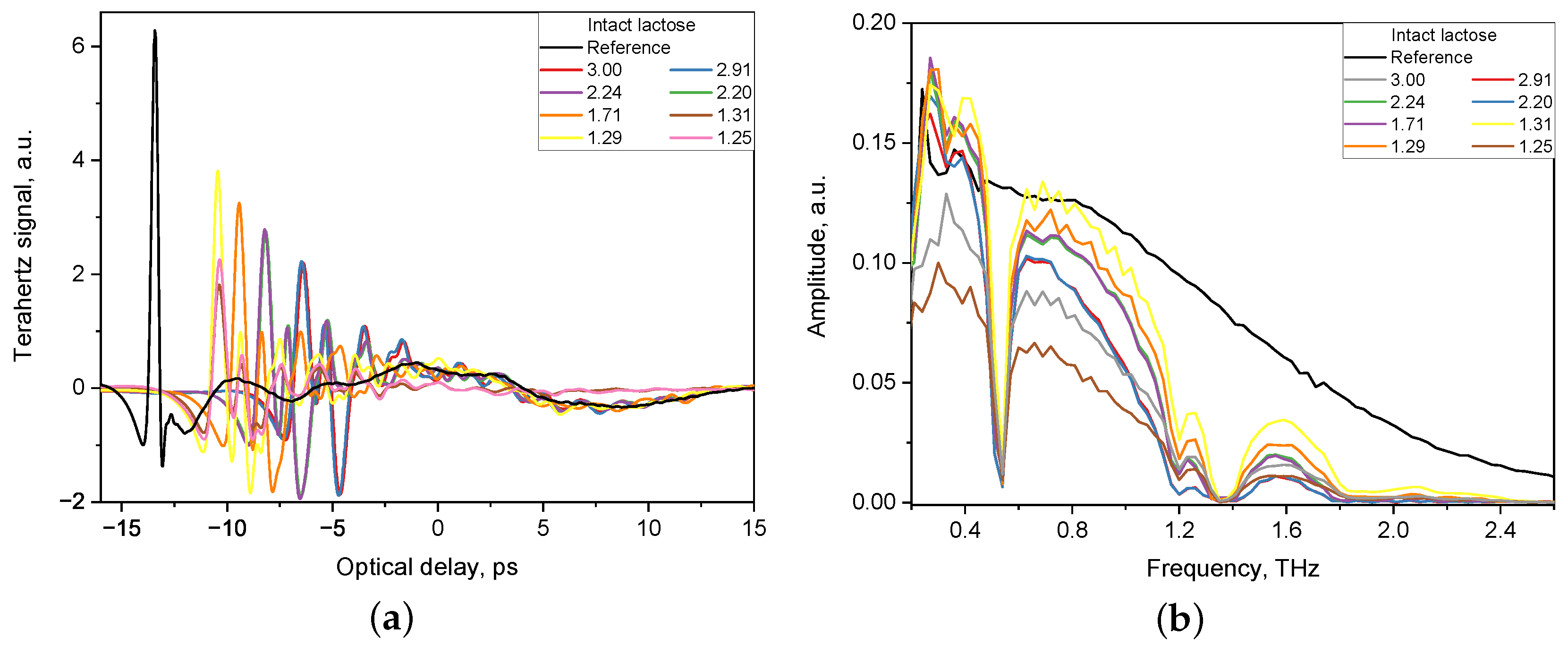
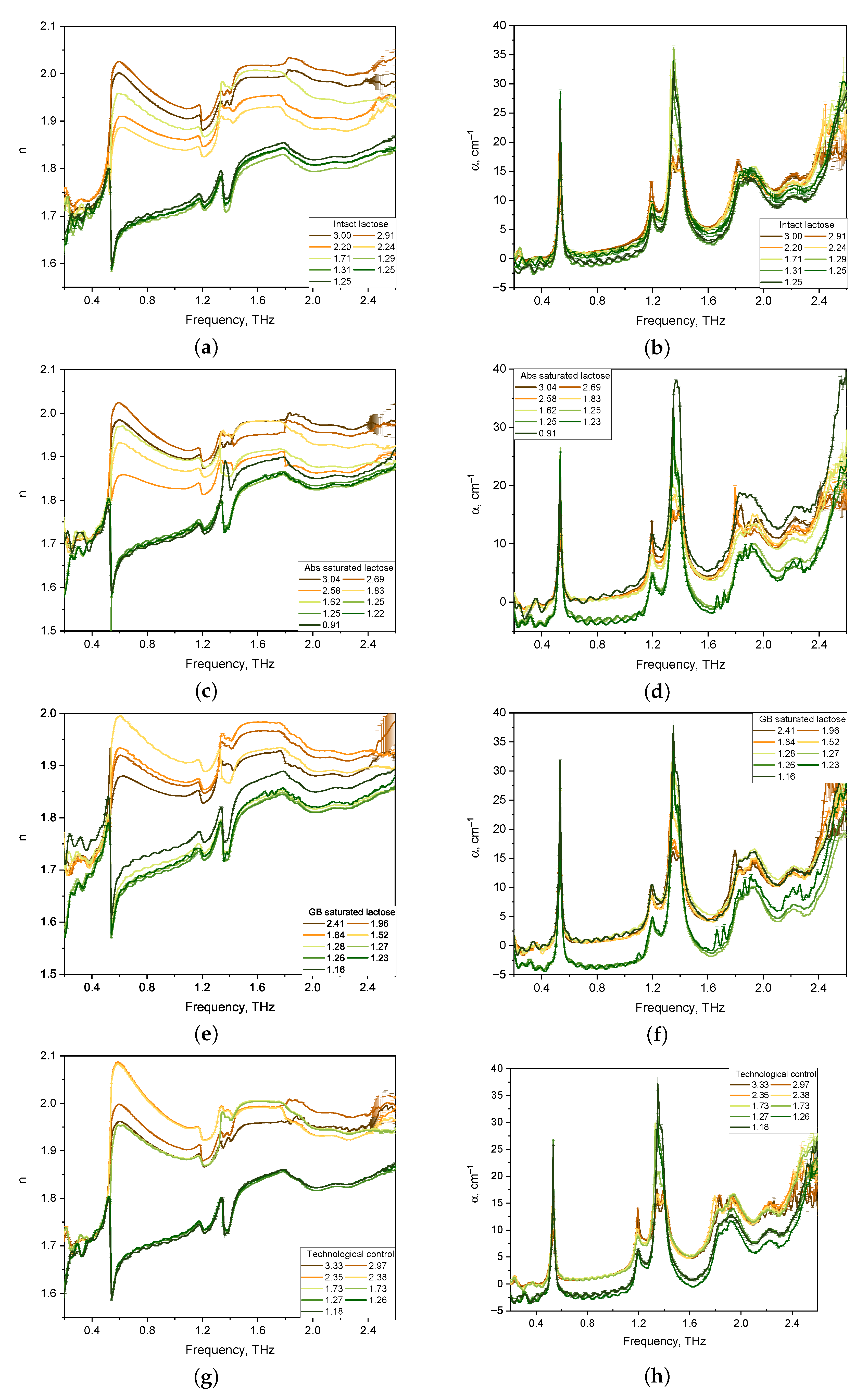
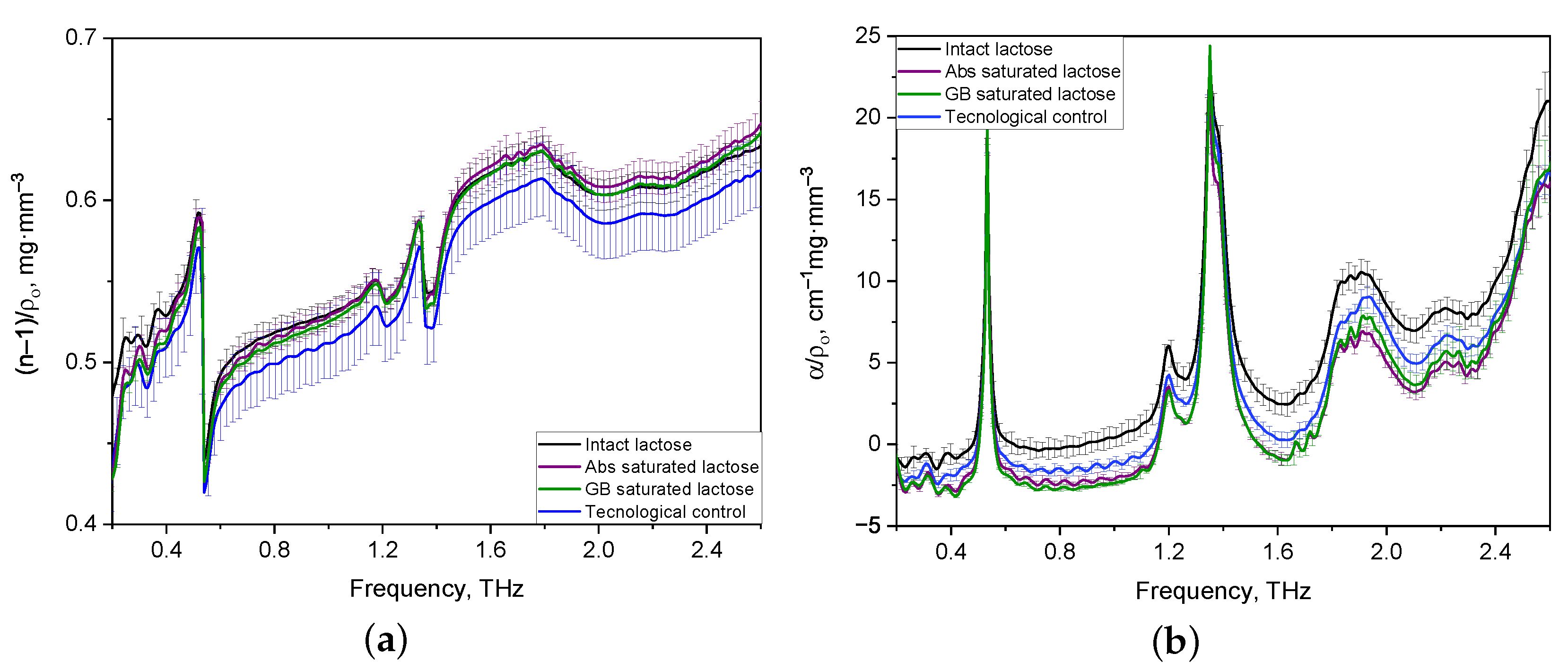
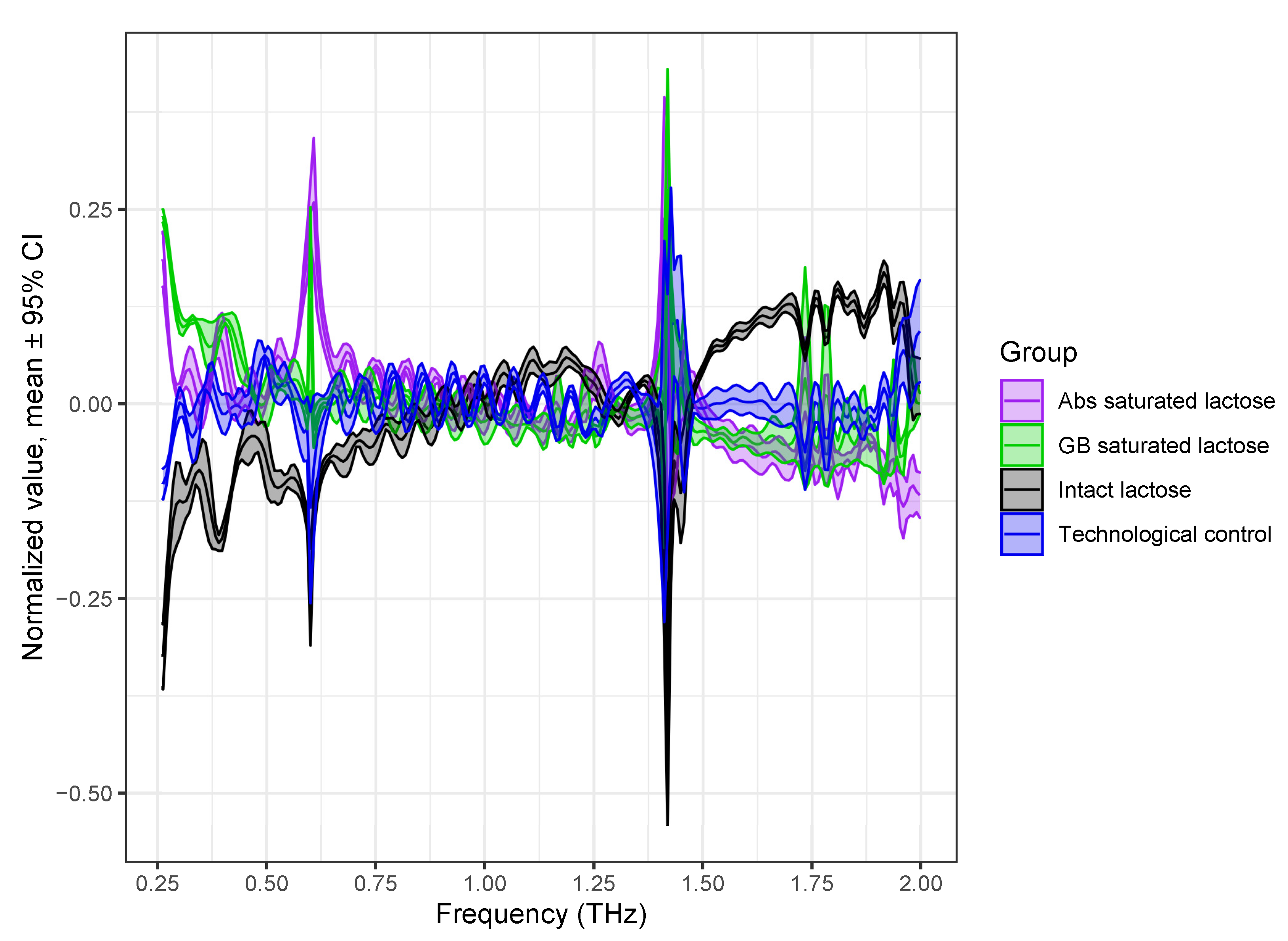
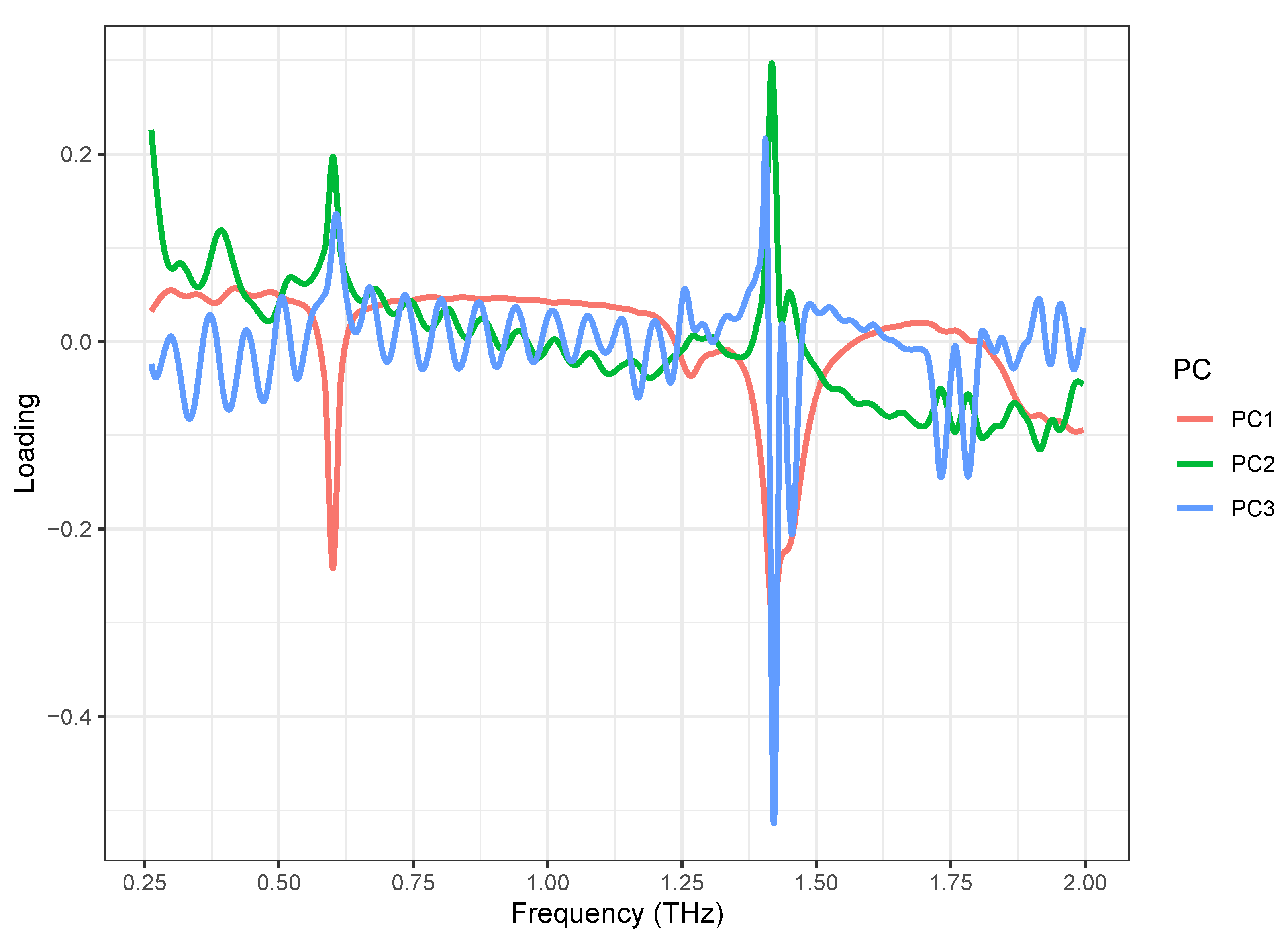

Publisher’s Note: MDPI stays neutral with regard to jurisdictional claims in published maps and institutional affiliations. |
© 2021 by the authors. Licensee MDPI, Basel, Switzerland. This article is an open access article distributed under the terms and conditions of the Creative Commons Attribution (CC BY) license (https://creativecommons.org/licenses/by/4.0/).
Share and Cite
Baranova, A.; Lykina, A.; Antonova, D.; Smolyanskaya, O. Optical Properties of Crystalline Lactose Fluidized with Dilutions of Various Substances in the Terahertz Frequency Range. Pharmaceutics 2022, 14, 32. https://doi.org/10.3390/pharmaceutics14010032
Baranova A, Lykina A, Antonova D, Smolyanskaya O. Optical Properties of Crystalline Lactose Fluidized with Dilutions of Various Substances in the Terahertz Frequency Range. Pharmaceutics. 2022; 14(1):32. https://doi.org/10.3390/pharmaceutics14010032
Chicago/Turabian StyleBaranova, Anna, Anastasiya Lykina, Daria Antonova, and Olga Smolyanskaya. 2022. "Optical Properties of Crystalline Lactose Fluidized with Dilutions of Various Substances in the Terahertz Frequency Range" Pharmaceutics 14, no. 1: 32. https://doi.org/10.3390/pharmaceutics14010032





